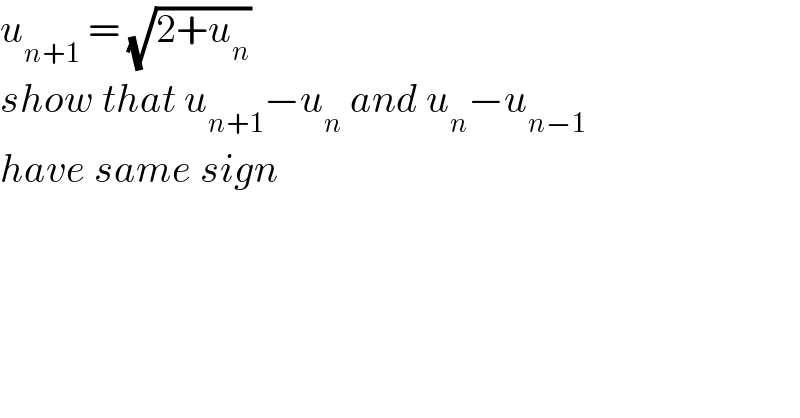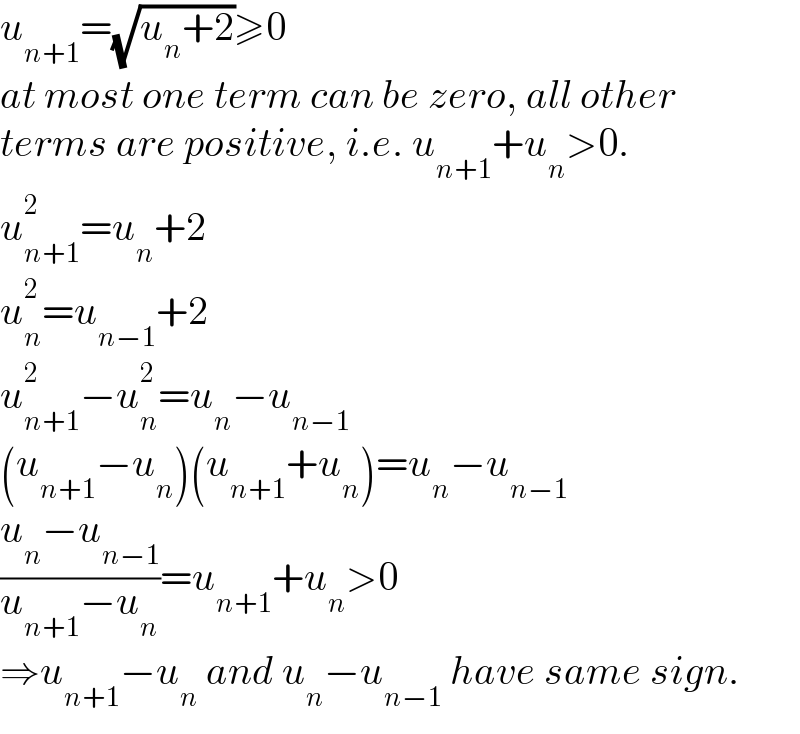Question Number 166648 by alcohol last updated on 24/Feb/22

$${u}_{{n}+\mathrm{1}} \:=\:\sqrt{\mathrm{2}+{u}_{{n}} } \\ $$$${show}\:{that}\:{u}_{{n}+\mathrm{1}} −{u}_{{n}} \:{and}\:{u}_{{n}} −{u}_{{n}−\mathrm{1}} \\ $$$${have}\:{same}\:{sign} \\ $$$$ \\ $$
Answered by mr W last updated on 24/Feb/22

$${u}_{{n}+\mathrm{1}} =\sqrt{{u}_{{n}} +\mathrm{2}}\geqslant\mathrm{0} \\ $$$${at}\:{most}\:{one}\:{term}\:{can}\:{be}\:{zero},\:{all}\:{other} \\ $$$${terms}\:{are}\:{positive},\:{i}.{e}.\:{u}_{{n}+\mathrm{1}} +{u}_{{n}} >\mathrm{0}. \\ $$$${u}_{{n}+\mathrm{1}} ^{\mathrm{2}} ={u}_{{n}} +\mathrm{2} \\ $$$${u}_{{n}} ^{\mathrm{2}} ={u}_{{n}−\mathrm{1}} +\mathrm{2} \\ $$$${u}_{{n}+\mathrm{1}} ^{\mathrm{2}} −{u}_{{n}} ^{\mathrm{2}} ={u}_{{n}} −{u}_{{n}−\mathrm{1}} \\ $$$$\left({u}_{{n}+\mathrm{1}} −{u}_{{n}} \right)\left({u}_{{n}+\mathrm{1}} +{u}_{{n}} \right)={u}_{{n}} −{u}_{{n}−\mathrm{1}} \\ $$$$\frac{{u}_{{n}} −{u}_{{n}−\mathrm{1}} }{{u}_{{n}+\mathrm{1}} −{u}_{{n}} }={u}_{{n}+\mathrm{1}} +{u}_{{n}} >\mathrm{0} \\ $$$$\Rightarrow{u}_{{n}+\mathrm{1}} −{u}_{{n}} \:{and}\:{u}_{{n}} −{u}_{{n}−\mathrm{1}} \:{have}\:{same}\:{sign}. \\ $$
